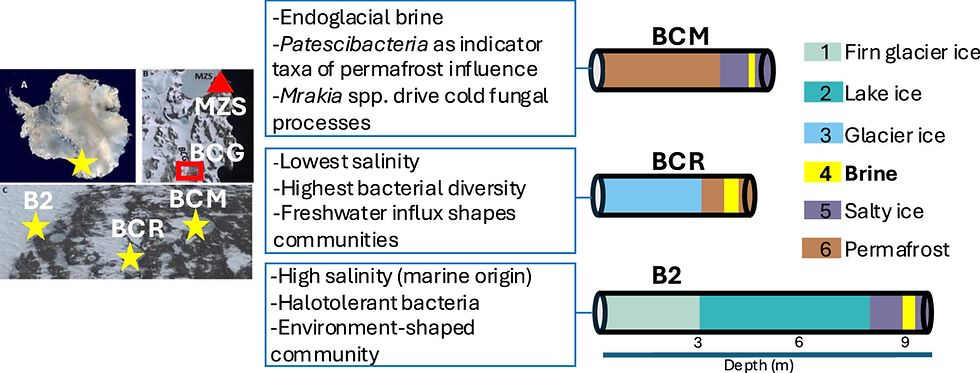Fungal infections: Pathogenesis, antifungals and alternate treatment approaches
- David Ojcius
- Jan 20, 2024
- 2 min read
Increasing incidence of fungal infections of recent times requires immediate intervention. Fungal infections are seldom construed at initial stages that intensify the severity of infections and complicate the treatment procedures. Fungal pathogens employ various mechanisms to evade the host immune system and to progress the severity of infections. For the treatment of diverse superficial and systemic infections, antifungal drugs from the available repertoire are administered. However, well documented evidence of fungal resistance to most of the antifungal drugs hampers disease control and poses challenges in antifungal therapy. Several physiological adaptations and genetic mutations followed by their selection in presence of antifungal agents drive the resistance development in fungi. The availability of limited antifungal arsenal, emergence of resistance and biofilm-conferred resistance drives the need for development of novel drugs and alternate approaches for the better treatment outcome against mycoses. This graphical review explicitly shed light on various fungal infections and causative organisms, pathogenesis, different antifungal drugs and resistance mechanisms including host immune response and evasion strategies. Here, we have highlighted recent developments on novel antifungal agents and other alternate approaches for fighting against fungal infections.
Introduction
Fungal infections are of serious public health concern. The incidence of fungal infections in patients with other diseases including Covid-19 is associated with life-threatening mycoses and mortality. Fungal infections can include superficial, cutaneous, sub-cutaneous, mucosal and systemic infections with varying degree of severity. Organisms such as Candida spp. are part of human microbiota that can cause opportunistic infections in individuals and life threatening infections (invasive candidiasis) in immuno-compromised patients such as HIV patients, cancer patients receiving chemotherapy, and patients receiving immuno-suppressive drugs. Besides, opportunistic and systemic infections, fungal pathogens such as Candida, Aspergillus, Fusarium, Mucorales and molds can cause healthcare-associated infections (HAI) in patients with underlying diseases (Perlroth et al., 2007). In certain geographical areas, fungal pathogens cause prevalent life-threatening endemic mycoses such as Blastomycosis, Coccidiodomycosis, Histoplasmosis, Talaromycosis, Paracoccidiodomycosis and Sporotrichosis (Lee and Lau, 2017).
Systemic fungal infections are often diagnosed lately increasing mortality rates. Centers for Disease Control and Prevention (CDC) has declared September 20–24, 2021 as fungal disease awareness week, to educate and to highlight the importance of early diagnosis of fungal infections to alleviate the debilitating effects (CDC website). This article provides an overview of the spectrum of fungal infections in humans, pathogenesis, immune evasion mechanisms, antifungal drugs along with their mode of action, resistance mechanisms and alternate antifungal approaches to combat fungal infections.
2. Fungal pathogens and routes of transmission
The sub-kingdom Dikarya of fungi comprising of the phyla Ascomycota and Basidiomycota is the major contributor of all fungal pathogens and infections in humans. Ascomycota organisms are known for causing oropharyngeal, otolaryngeal, dermatological, ophthalmic, neuronal, genitourinary, cardiac, pulmonary and systemic infections (Fig. 1). The organisms of Basidiomycota such as Cryptococcus and Malassezia are well-known for invasive meningitis and superficial skin infections, respectively.
Fungal pathogens primarily use direct contact and/or inhalation route for transmission. Dermatophytic fungi belonging to the genera of Microsporum, Epidermophyton and Trichophyton, Sporothrix and Malassezia spp. infect the damaged skin by direct contact (Fig. 2A).They produce various proteolytic enzymes to cause superficial mycoses in keratinized tissues. The other predominant route for transmission is by inhalation of spores/ conidia that instigates pulmonary infections. Blastomyces dermatitidis (Blastomycosis), Paracoccidioides brasiliensis and P. lutzii (Paracoccidiodomycosis), Histoplasma capsulatum (Histoplasmosis), Pneumocystis jirovecii (Pneumocystis pnuemonia), Aspergillus fumigatus and A. flavus (Aspergillosis), Coccidioides immitis and C. posadasii (Coccidioidomycosis), C. neoformans and C. gattii (Cryptococcosis) are mainly transmitted through inhalation. While, Talaromyces marneffei (talaromycosis) uses both direct contact and inhalation route for transmission.
Free article. Read more at:








Comments